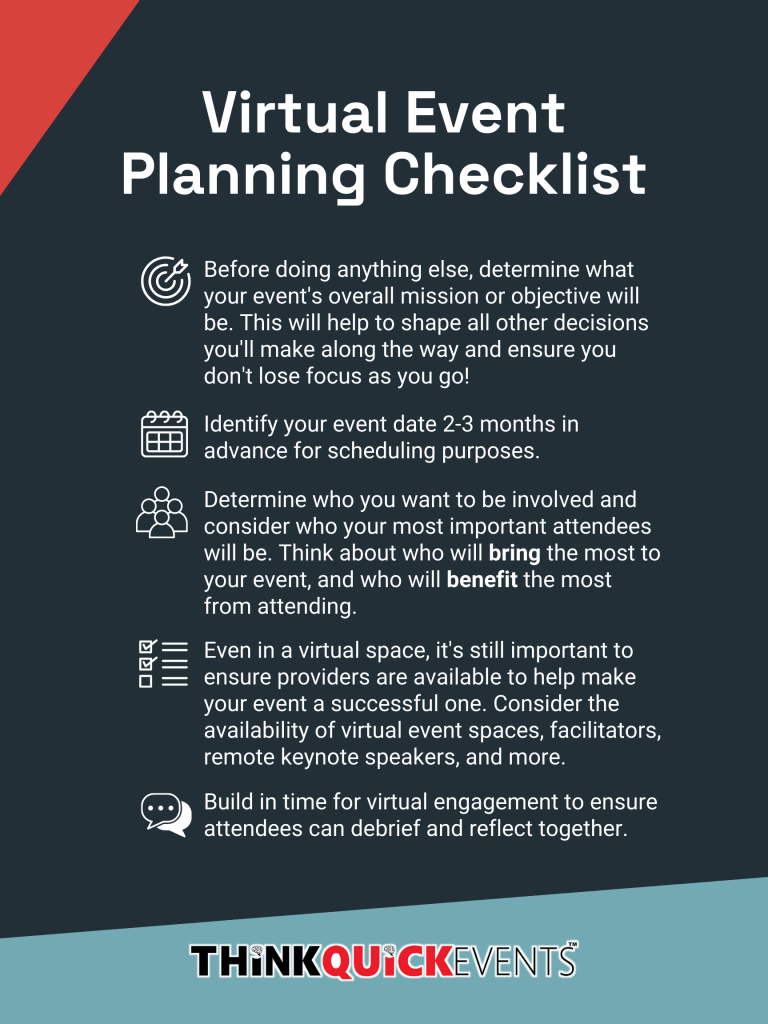Just like a traditional in-person event, virtual team building and remote team events require organizers to have all their ducks in a row.
Careful planning ahead of time helps that by the time your much-anticipated event comes along, you’ll have accounted for and addressed any last-minute issues and taken care of the “big picture” items. The last thing you want to be dealing with, mere hours before event kickoff, are last-minute fires that could’ve been avoided with good planning and early preparation!
Our team of highly experienced virtual event planners have put together a virtual event planning checklist to help make your next team building event your best yet! While many of these tips apply to events in the remote team building space, you’ll find that they’re still helpful when thinking about traditional in-person events, too.
Read on and scroll your way to the end of this post for a downloadable graphic that will help guide you through your next event planning process.
Step One: Determine Your Event’s Overall Mission or Objective
Determining your event’s overall mission or objective should always be the first step in event planning, whether you’re hosting in-person or virtually. It not only helps to set the tone, but it can help frame that every subsequent decision you make along the way aligns with your overall goal.
For some groups, events are all business: perhaps you’re unveiling quarterly or year-end results or discussing new department structuring. For others, fun is the key outcome, giving employees a chance to kick back, relax, and create new team bonds.
At Think Quick Events, the overall goal can serve both ends of the spectrum: attendees can casually connect in a fun and lighthearted way while also building new skills and team bonds that will pay off in the workplace.
Whatever your intended outcome, make it clear to all those involved in the planning process and keep it concise to keep you on the right track as you move forward.
Step Two: Set a Date
To give you enough time to prep for your event and provide attendees with adequate notice to participate, two to three months of lead time is typically sufficient. Though, of course, there’s nothing wrong with trying to turn something around with just a week’s worth of planning… but we’ve all felt the crunch from trying to pull that off, and there’s no guarantee that others who are important to your event – including key speakers, service providers, and even your attendees! – may be available to join on short notice.
Of course, this will depend on many other factors, including the size and scale of your event, what time of year you’re planning for, and much, much more.
Step Three: Determine Who You Want to Be Involved
Step three is all about determining who you want to be involved and engaged in your event. Identifying the most important people that need to be there, either because they have something key to contribute or take away from the event is essential for a successful virtual team building event.
Think about who will bring the most to your event, and who will benefit the most from attending.
Be sure to consider both internal and external attendees – often, there are several outside stakeholders who are just as pivotal to a company’s success as those on the inside.
Step Four: Consider Who Can Help Make Your Event a Success
You might think that virtual events are vastly different than your traditional in-person affairs, but they’re quite similar. Depending on what kind of event you’re holding, you’ll still have to consider availability and coordination when it comes to:
- Virtual event spaces and service providers
- Event facilitators and activity providers
- Keynote speakers or guest lecturers
- And more
Think about what kind of involvement you’d like them to have and check that they’ve got the time and capacity to commit.
Step Five: Build in Time for Virtual Engagement and Reflection
Although this point comes last, it’s arguably one of the most important things to consider when you’re designing or developing your virtual event.
Building in time for virtual engagement or reflection throughout an event is critical to give attendees an opportunity to speak up about the immediate utility of the experience and the lasting power of what’s been learned. Time to reflect as a group helps to open a team’s communication channels and translate to real-life successes in the workplace.
Conversational prompts can be used to get the conversation among attendees started, but authentic conversation is where the magic really happens!
Get Your FREE Virtual Event Planning Checklist

There’s always the option to wholeheartedly put your event in the hands of a professional – reach out to the team at Think Quick Events to learn more about our roster of virtual team building activities and how they can be customized to suit your group’s needs.

